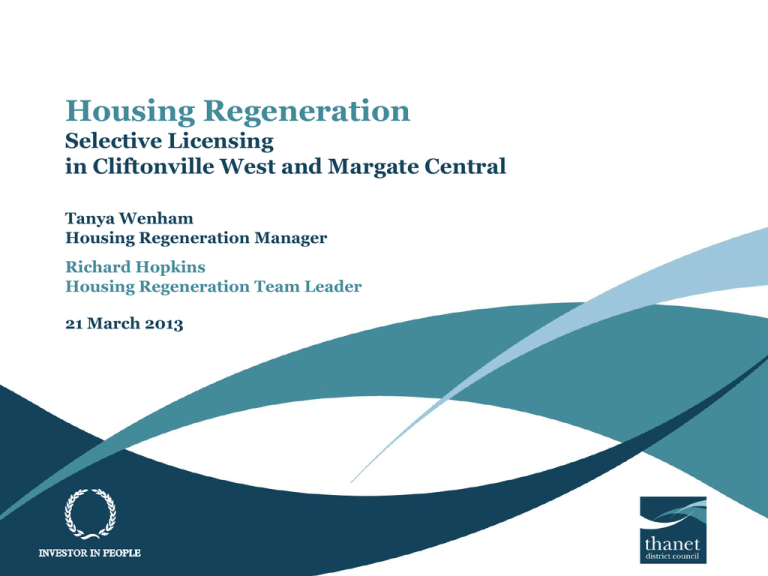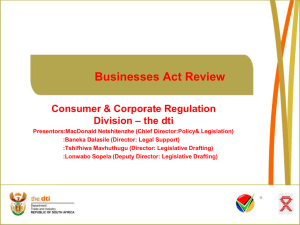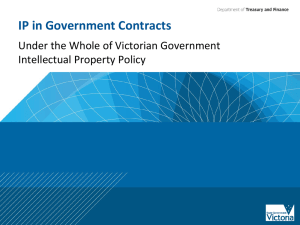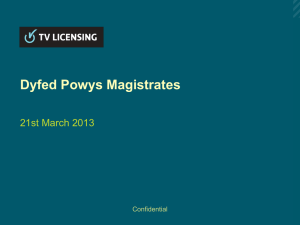Tanya Wenham, Selective Licencing Presentation
advertisement

Housing Regeneration Selective Licensing in Cliftonville West and Margate Central Tanya Wenham Housing Regeneration Manager Richard Hopkins Housing Regeneration Team Leader 21 March 2013 Is selective licensing the best option? Distinct area in district with significant issues compared to the rest of the district? Evidence of high level of private rented sector? Large amount of resources directed to deal with issues in the area? Evidence of crime and ASB? High levels of empty properties? If yes – where do you begin? Look at the guidance and the Housing Act 2004 Look at the criteria for making a designation and gather the evidence to support each element. Determine if low housing demand or ASB or both Identify what activity has already been undertaken and why this has failed Determine how selective licensing will improve the area Identify how this fits with local policies and strategies – in particular housing strategy Low housing demand A selective licensing designation can only be made if one or both of the sets of general conditions have been satisfied The first set concerns “Low Housing Demand”: – That the area is, or is likely to become, an area of low housing demand; and – that making a designation will, when combined with other measures taken in the area by the local housing authority, or by other persons together with the local housing authority, contribute to the improvement of the social or economic conditions in the area. Anti-social behaviour The second set concerns “Anti-social Behaviour”: – that the area is experiencing a significant and persistent problem caused by anti-social behaviour; – that some or all of the private sector landlords who have let premises in the area (whether under leases or licences) are failing to take action to combat the problem that it would be appropriate for them to take; and – that making a designation will, when combined with other measures taken in the area by the local housing authority, or by other persons together with the local housing authority, lead to a reduction in, or the elimination of, the problem. Drafting the proposal Prepare draft proposal Include map of area and addresses Ensure all sections of the Act have been covered Present the evidence visually/mapped Set objectives – what do you want to achieve with the designation? What other activity is being undertaken to support the designation and the objectives? Set proposed fees Identify how you will ensure compliance Setting fees Can only recover the costs of processing a licence Can’t include enforcement costs Can’t include inspection costs Must identify what the fees will be spent on Can only be used to cover the costs of processing the licence i.e. officer time and associated costs such as postage, printing, publicity of scheme to encourage compliance Not a mechanism for income generation Consultation Minimum 10 week consultation Area of challenge Full communications plan to ensure maximum exposure Make feedback easy Workshops, fliers, speak to community and engage with landlords, advertise and publicity, public meetings Purchase land registry info to write to all property owners Ensure staff and Members are fully trained on objectives and purpose to give consistent message Be prepared for negativity After consultation Review all comments Amend proposal to take account of consultation responses Consider all possible options before decision to designate is made Ensure correct decision making process is followed Resources Need to be prepared to provide up front funding for set up and preparing proposal Don’t underestimate resources required in dealing with consultation Any fee income should be ring fenced and may not be spent if scheme is subject to judicial review Need to consider level of resource to ensure delivery of objectives within the 5 year designation, including inspection programme Need to engage partners to deliver ASB elements Judicial Review Lodged in the High Court by the Southern Landlords Association (SLA) in March 2011 Long wait for initial decision Autumn 2011 – JR may go ahead Spring 2012 – JR set for 30-31 October 2012 Decision handed down in November 2012 JR dismissed Thanet District Council’s decision to designate on the basis of both ASB and low housing demand confirmed as lawful Impact of Judicial Review Delayed full implementation by 2 years Unable to undertake full enforcement during this period Unable to use fee income to cover staff costs Compliant landlords wanting to see action against noncompliant Limited ability to instigate significant change in the area Implementation Application process Licence conditions Encouraging compliance Enforcement and inspection Penalties Resources needed for delivery Monitoring and measuring success Where are we now Applications Landlords MUST apply for a licence Must be accompanied by the correct fee (£442/£546) Online application process provided by GOV.UK Paper application forms can be provided if necessary Applications must include property plans, gas safety records, and a copy of the tenancy agreement Proposed licence holder/manager must be a fit and proper person Application types There are two types of application DWELLING application – For single houses or flats – If the dwelling is a flat, the licence will only apply to the individual flat and not to any common parts BUILDING application – For applicants who own the freehold of a building and one or more flats within it – Licence will apply to all flats under the control of the freeholder and the common parts Licence conditions Conditions are attached to all licences Some are mandatory (prescribed by the Housing Act 2004) Conditions may be set to regulate management, use and occupation (less scope than HMO licensing) Licences contain around 18 conditions relating to: – – – – – – – – – – Maximum permitted occupation Tenant referencing Written statement of the terms of occupation (tenancy agreements) Anti-social behaviour Waste management General management Amenities and space heating Furniture, gas and electrical safety Security and fire safety Duty to notify council of changes ASB licence condition The licence holder/manager must take all reasonable steps available to them to tackle ASB being perpetrated by their tenants and visitors. The licence holder/manager must co-operate with the Police and Council officers. The tenancy must include a clause, or clauses, requiring the tenant to refrain from ASB and take all reasonable steps to prevent their visitors from engaging in ASB. Encouraging compliance Early application discount (until 31 July 2011) Discount for accredited landlords Stage payment system for larger landlords (10+ properties) Publicity (website banners, newspaper adverts) Engagement (landlord events, landlord focus group, etc.) Approach to enforcement and inspection Gathering information (land registry, Your Home Your Health, housing benefits, complaints, public representations, referrals from other departments and partner agencies) Typical procedure involves two reminder letters Reminders often result in a new application Inspection not part of the application process Programmed inspection regime starting shortly HHSRS to be completed Licence conditions checked Penalties It is an offence not to licence a property that is subject to selective licensing Maximum fine £20,000 It is an offence not to comply with the conditions of a selective licence Maximum fine £5,000 per offence Defence of “reasonable excuse” Revocation of licence (as person may no longer be fit and proper) Rent repayment orders Interim and final management orders Section 21 notices (Notice to quit) Resources needed for delivery Considerable landlord support needed (expect a large number of long telephone conversations) Large number of defective applications Strict prescribed licensing process (no short-cuts – need to make it efficient) Team Leader, eight officers, and three admin working on licensing Do not underestimate resources required – unlikely to be viable without additional staff Monitoring and measuring success Set up your systems to be able to record relevant activity (designated area may not match ward boundaries) Liaise with ASB unit, the Police and other departments to ensure that they can give you the information you need Relevant data can be drawn from a range of sources, including: – – – – – – PSH activity ASB complaints Crime Waste complaints No. of empty properties Council Tax/Housing Benefit Where are we now? Over 800 applications made in respect of 1400 dwellings Over 1100 dwellings currently subject to a licence Enforcement underway – first batch of prosecutions in near future Currently advertising in Kent on Sunday (full page advert) Closer working relationship with ASB/Police Problem properties sold Tenant referencing scheme going live in April Questions?







